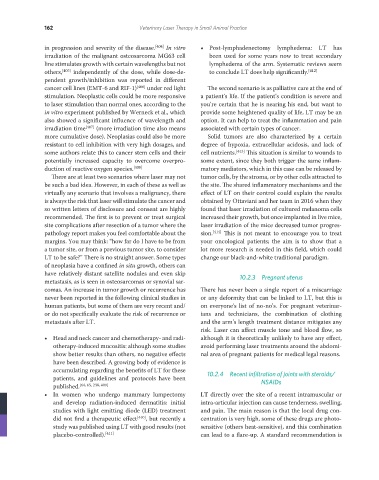Page 176 - Veterinary Laser Therapy in Small Animal Practice
P. 176
162 Veterinary Laser Therapy in Small Animal Practice
in progression and severity of the disease. [404] In vitro • Post-lymphadenectomy lymphedema: LT has
irradiation of the malignant osteosarcoma MG63 cell been used for some years now to treat secondary
line stimulates growth with certain wavelengths but not lymphedema of the arm. Systematic reviews seem
others, [405] independently of the dose, while dose-de- to conclude LT does help significantly. [412]
pendent growth/inhibition was reported in different
cancer cell lines (EMT-6 and RIF-1) [406] under red light The second scenario is as palliative care at the end of
stimulation. Neoplastic cells could be more responsive a patient’s life. If the patient’s condition is severe and
to laser stimulation than normal ones, according to the you’re certain that he is nearing his end, but want to
in vitro experiment published by Werneck et al., which provide some heightened quality of life, LT may be an
also showed a significant influence of wavelength and option. It can help to treat the inflammation and pain
irradiation time [407] (more irradiation time also means associated with certain types of cancer.
more cumulative dose). Neoplasias could also be more Solid tumors are also characterized by a certain
resistant to cell inhibition with very high dosages, and degree of hypoxia, extracellular acidosis, and lack of
some authors relate this to cancer stem cells and their cell nutrients. [413] This situation is similar to wounds to
potentially increased capacity to overcome overpro- some extent, since they both trigger the same inflam-
duction of reactive oxygen species. [408] matory mediators, which in this case can be released by
There are at least two scenarios where laser may not tumor cells, by the stroma, or by other cells attracted to
be such a bad idea. However, in each of these as well as the site. The shared inflammatory mechanisms and the
virtually any scenario that involves a malignancy, there effect of LT on their control could explain the results
is always the risk that laser will stimulate the cancer and obtained by Ottaviani and her team in 2016 when they
so written letters of disclosure and consent are highly found that laser irradiation of cultured melanoma cells
recommended. The first is to prevent or treat surgical increased their growth, but once implanted in live mice,
site complications after resection of a tumor where the laser irradiation of the mice decreased tumor progres-
pathology report makes you feel comfortable about the sion. [414] This is not meant to encourage you to treat
margins. You may think: “how far do I have to be from your oncological patients; the aim is to show that a
a tumor site, or from a previous tumor site, to consider lot more research is needed in this field, which could
LT to be safe?” There is no straight answer. Some types change our black-and-white traditional paradigm.
of neoplasia have a confined in situ growth, others can
have relatively distant satellite nodules and even skip 10.2.3 Pregnant uterus
metastasis, as is seen in osteosarcomas or synovial sar-
comas. An increase in tumor growth or recurrence has There has never been a single report of a miscarriage
never been reported in the following clinical studies in or any deformity that can be linked to LT, but this is
human patients, but some of them are very recent and/ on everyone’s list of no-no’s. For pregnant veterinar-
or do not specifically evaluate the risk of recurrence or ians and technicians, the combination of clothing
metastasis after LT. and the arm’s length treatment distance mitigates any
risk. Laser can affect muscle tone and blood flow, so
• Head and neck cancer and chemotherapy- and radi- although it is theoretically unlikely to have any effect,
otherapy-induced mucositis: although some studies avoid performing laser treatments around the abdomi-
show better results than others, no negative effects nal area of pregnant patients for medical legal reasons.
have been described. A growing body of evidence is
accumulating regarding the benefits of LT for these 10.2.4 Recent infiltration of joints with steroids/
patients, and guidelines and protocols have been NSAIDs
published. [64, 65, 238, 409]
• In women who undergo mammary lumpectomy LT directly over the site of a recent intramuscular or
and develop radiation-induced dermatitis: initial intra-articular injection can cause tenderness, swelling,
studies with light emitting diode (LED) treatment and pain. The main reason is that the local drug con-
did not find a therapeutic effect [410] , but recently a centration is very high, some of these drugs are photo-
study was published using LT with good results (not sensitive (others heat-sensitive), and this combination
placebo-controlled). [411] can lead to a flare-up. A standard recommendation is
REDONDO PRINT (4-COL BLEED).indd 162 08/08/2019 09:48

